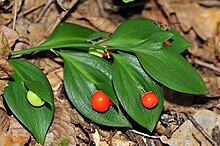|
Ruscus hypoglossum
Ruscus hypoglossum is a small evergreen shrub with a native range from Italy north to Austria and Slovakia and east to Turkey and Crimea.[1] Common names include spineless butcher's-broom,[2] mouse thorn and horse tongue lily. The species name comes from two Greek words ὑπό (hypo) and γλῶσσα (glōssa) meaning under and tongue. DescriptionThe mature plant shrub will eventually reach about 46 cm (18 in) in height. It has a creeping rootstock and leaf-like phylloclades or flattened stems that are about 8 cm (3 in) long to 4 cm (1+1⁄2 in) wide tapering at both ends. True leaves are smaller green appendages around the flowers. Small yellow flowers bloom in the axil of a leaf-like bract 2.5–3.8 cm (1–1.5 in) long on upper side of phylloclade. Plants are dioecious, with male and female flowers produced on separate plants.[3] Fruit is a rarely produced red globose berry 0.6 to 1.3 cm (0.25 to 0.5 in) wide.[4] Gallery
EtymologyRuscus is derived from an old Latin name for prickly plants.[5] The specific epithet hypoglossum is derived from Greek and means 'sheathed beneath' or 'below-a-tongue'. The name is in reference to the cladodes of this species, which extend beneath the flowers.[5] References
|
||||||||||||||||||||||||||||




